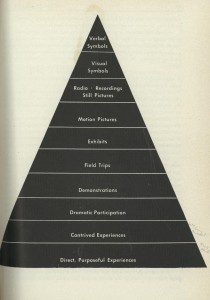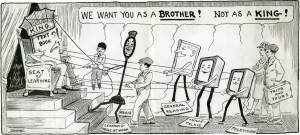Edgar Dale, Educational Radio, and Sensory Learning
Post by Brian Gregory, Pace University
 Much research on educational technology reforms in the twentieth century has placed emphasis on the idea that their inception and implementation has often been accompanied by a feverish excitement that sooner or later subsides. What is left, some of this research has argued, has been an all-too-common story of misuse and misguided aspirations. [1]
Much research on educational technology reforms in the twentieth century has placed emphasis on the idea that their inception and implementation has often been accompanied by a feverish excitement that sooner or later subsides. What is left, some of this research has argued, has been an all-too-common story of misuse and misguided aspirations. [1]
There have been many such reforms attempted in education since the end of the nineteenth century that have elicited widespread excitement about the potential for new forms of learning. Many of these reforms were backed by progressive educators in the early twentieth century. Edgar Dale, a professor at Ohio State University and a researcher at the university’s Bureau of Educational Research, identified himself as part of the progressive education movement. His instructional philosophy can be understood through a pyramid-like structure that he called the “Cone of Experience” (pictured right) in which he classified and detailed his beliefs about sensory and experiential learning.
Dale placed learning through direct experience at the bottom of the pyramid. Moving vertically up the figure, illustrated a shift in learning as it began to occur less through immediate experience, more through mediated means, and also became more conceptual and abstract. At the bottom of the cone, direct sensory learning provided students with rich experiences that included field trips, bird watching, fishing trips, and other types of worldly excursions. Next, came models and mockups of real experiences, such as miniature versions of airplanes, ships, and landscape scenes. These had educational value because they provided students with opportunities for scrutiny and analysis of structures, processes, and systems that could not be recreated through lecture and textbooks. Dramatic participation was the next up the pyramidal diagram. School plays were an example of this in which students either participated as actors or watched as spectators. Next came demonstrations enacted by the teacher, then field trips to cultural centers, and museum exhibitions, all of which had students function more as viewer than participant. Near the top of the cone was instruction that employed educational technologies including radio, film, newspapers, and phonograph records. [2] To Dale, instruction with technology did not occur on a “direct sensory level”, but he saw this type of learning as important and necessary because it allowed students to encounter and examine the intellectual and emotional elements that were interwoven into many carefully devised media programs.
Dale spent much of his corpus examining the use of motion pictures in education, but in a large number of his writings he argued for the value of learning through all the senses, including the ears. [3] Dale was also involved with the the Ohio School of the Air educational radio program at Ohio State University. In the 1935 inaugural issue of The News Letter, he argued for more research into the aural nature of radio programming. [4]
 A nameless author, affiliated with the Ohio School of the Air, wrote a paper called “Will King Textbook Be Dethroned,” which illustrated Dale’s ideas about auditory education. In the paper, the author proclaimed that radio “become[s] a new sort of textbook – aural instead of visual.” [5] The author illustrated this point in a cartoon (pictured left) that depicts a textbook, aptly named “King Textbook,” perched on a throne.
A nameless author, affiliated with the Ohio School of the Air, wrote a paper called “Will King Textbook Be Dethroned,” which illustrated Dale’s ideas about auditory education. In the paper, the author proclaimed that radio “become[s] a new sort of textbook – aural instead of visual.” [5] The author illustrated this point in a cartoon (pictured left) that depicts a textbook, aptly named “King Textbook,” perched on a throne.
Educational radio was often characterized as a medium that encouraged passive listening and learning. The criticism was that students who listened to programs on the radio tended to sit lifeless in their seats while a radio instructor came through the ether into their classrooms to play music and authoritatively tell them what to think and feel. At a 1932 conference, Edgar Dale struck back at these sorts of characterizations with the argument that there was no such thing as passive listening and that listening should be seen as an activity in itself.
In the 1940s, numerous research studies investigated the efficacy of sensory learning. In a meta-analysis on audio-visual education, written in 1945, one author looked at learning with radio versus learning without radio and studies that compared learning that involved visuals with learning without them. [6] The writer concluded that these studies “were inconclusive” and did not provide “definite proof” on the efficacy of auditory or visual learning through their respective technologies. Another group of researchers three years earlier had commented on studies that compared aural to visual learning, most notably one study by Paul Lazarsfeld from the Office of Radio Research at Columbia University called Radio and the Printed Page, in which he stated that “for every study which shows that the ear is more receptive, another study can be quoted which attributes the same advantage to the eye.” [7] Lazarsfeld had concluded, according to the researchers, that what was most important was how well people concentrated on the medium at hand and their present context.
More recently, studies have shown that there has been “no scientific evidence backing up the idea” that teaching should be augmented for various learning styles even though “an entire industry has sprouted” up to support it. [8] Other contemporary research has shown that learning is more effectual when it is varied and integrates various styles than when it targets only one mode of communication and one style of learning. [9] What is important, as Dale argued, is that in order for sensory learning, involving educational technologies, to be useful, educators must have an explicit understanding about the types of lessons that make these technologies educational, how to use them in productive ways, and have clearly defined objectives that will result in effective educational experiences for students.
[1] David B. Tyack and Larry Cuban, Tinkering toward Utopia : A Century of Public School Reform (Cambridge, Mass.: Harvard University Press, 1995) 111
[2] Edgar Dale, “Coming to Our Senses,” The News Letter 5, no. 1 (November 1939).
[3] Audio-Visual Methods in Teaching (New York: The Dryden Press, 1946) 48
[4] Edgar Dale and I. Keith Tyler, “Foreward, the Radio,” The News Letter 1, no. 1 (November 1935).
[5] OSU Ohio School of the Air (RG 8d6), Box 1. Ohio Teaches School By Radio, n.d.
[6] Arthur C. Stenius, “Auditory and Visual Education,” Review of Educational Research 15, no. 3 (1945): 246.
[7] Seerley Reid and Daniel Day, “Chapter Vi: Radio and Records in Education,” Review Of Educational Research 12, no. 3 (June 1942): 313.
[8] Patti Neighmond, “Think You’re an Auditory or Visual Learner? Scientists Say It’s Unlikely,” http://www.npr.org/blogs/health/2011/08/29/139973743/think-youre-an-auditory-or-visual-learner-scientists-say-its-unlikely.
[9] Richard E. Mayer, “A Cognitive Theory of Multimedia Learning,” in Multimedia Learning (Cambridge: Cambridge University Press, 2001).


